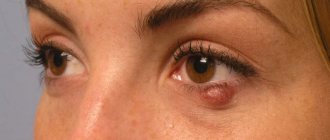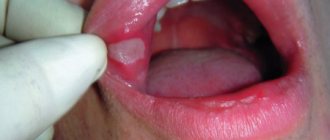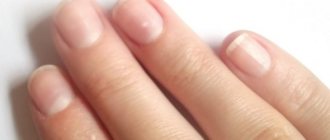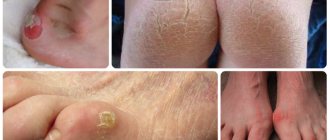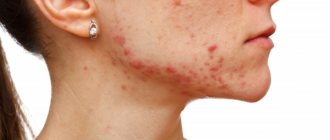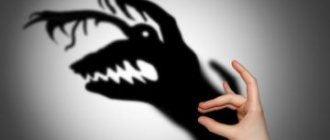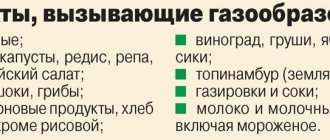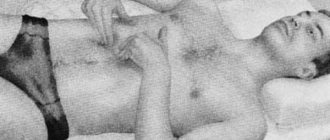Ptosis of the upper eyelid is a pathology in which it droops down, completely or partially blocking the palpebral fissure. This cosmetic defect greatly distorts a person’s appearance and prevents him from looking normally. Ptosis can be caused by various reasons, both minor and quite serious. In severe cases, a person tilts his head back to see objects better. Treatment is most often performed surgically. You can also do massage, eye exercises and use folk remedies. Conservative treatment is practically not used due to its low effectiveness.
Causes
Ptosis of the upper eyelid is manifested under the influence of the following factors:
- Hereditary deviations.
- Abnormal fetal development during pregnancy.
- Injury to the visual apparatus.
- Surgery on the eyes.
- Long-term use of hormonal medications.
- Formation of tumors in the brain.
- Disruption of the endocrine system.
- Stretching in the area where the upper eyelid muscle joins the tendon.
- Age-related drooping of skin folds due to gravity.
- Pathological processes affecting the nervous system.
| The congenital anomaly is often accompanied by strabismus or amblyopia. It usually affects both eyes. The acquired form affects only one eye. |
Causes of drooping eyelids
The upper eyelid is more than just a flap of skin. The eyelid consists of a muscle that attaches to the cartilage in the eye socket. The muscle (it is called the muscle that lifts the upper eyelid) is located in the thickness of the subcutaneous fat.
The main causes of the pathology:
- a congenital disease that is associated with insufficient development of the muscle designed to lift the upper eyelid;
- injury to the muscle that lifts the upper eyelid;
- damage to the oculomotor nerve;
- stretching of the tendon of the muscle that lifts the upper eyelid (this condition is typical for old age);
- damage to the cervical sympathetic plexus (the so-called Horner's syndrome, expressed in ptosis, constriction of the pupil and “retraction” of the eyeball);
- diabetes mellitus as a cause of metabolic damage to muscles and nerves;
- acute cerebrovascular accident (in this case, drooping eyelid is accompanied by a number of other symptoms);
- tumor of the brain, spinal cord, or neck area;
- disturbance of neuromuscular transmission (myasthenia gravis or myasthenic syndrome);
- damage to the oculomotor nerve as part of polyneuropathy (in combination with damage to a number of other peripheral nerves);
- complication of botulinum toxin administration for cosmetic or medicinal purposes;
- botulism.
Considering the many factors that lead to drooping eyelids, consultation with a doctor is mandatory.
At CELT you can get advice from a neurologist.
- Initial consultation – 4,000
- Repeated consultation – 2,500
Make an appointment
Classification
Depending on the moment at which the pathology developed, it is divided into congenital and acquired. The first form most often appears as a result of birth trauma or a difficult pregnancy.
Acquired ptosis is classified into several types depending on the cause of the pathology:
- The neurogenic form of the disease is diagnosed against the background of neurological diseases (ischemia, multiple sclerosis, meningitis). Accompanied by narrowing or dilation of the pupil of the affected eye, paralysis of the visual apparatus.
- The aponeurotic form occurs due to stretching or decreased tone of the muscles responsible for raising and holding the eyelid. Most often it is a consequence of plastic surgery for a facelift or botulinum therapy.
- Mechanical form. It develops after a violation of the integrity of the eyelid, the formation of scars from healed wounds and in the presence of large tumors on the surface of the skin. New growths, due to their severity, do not allow the eyelid to remain in its usual state, “pressing” it down.
- False form. Diagnosed due to peculiarities of the anatomical structure (for example, excess skin folds) or as a result of the development of ophthalmological diseases such as strabismus.
| In most cases, the deviation is detected in elderly people. But young people and children are also not protected from the development of ptosis. The cause of congenital drooping of the eyelid is the abnormal structure of the muscle responsible for raising the eye “sash” or damage to the nerve endings of the facial nerve. |
Diagnostics
As a rule, to make a diagnosis of ptosis, an external examination is sufficient, but in order to prescribe the correct treatment, it is necessary to establish the cause of the pathology and identify associated complications, for which the patient must undergo a series of diagnostic measures.
Diagnosis of the disease
- Determination of the degree of ptosis . To determine the degree of pathology, the MRD indicator is calculated - the distance between the skin of the eyelid and the middle of the pupil. If the edge of the eyelid reaches the center of the pupil, the indicator is 0, if it is slightly higher, then the MRD is assessed as +1 to +5, if lower - from -1 to -5.
- Ophthalmological examination . Includes assessment of visual acuity, measurement of intraocular pressure, detection of visual field impairment, as well as external examination of eye tissue to identify hypotonicity of the superior rectus muscle and epicanthus, which indicates the presence of congenital ptosis.
- CT and MRI . They are carried out to identify pathologies that could lead to the development of ptosis - disruption of the nervous system, neoplasms of the spinal cord and brain, etc.
MRI machine
Important: when diagnosing ptosis of the upper eyelid, it is very important to distinguish congenital pathology from the acquired form, since the treatment tactics of the disease largely depend on this.
Degrees
The disease is classified into three types according to the degree of prolapse:
- Partial ptosis. Covers a maximum of 1/3 of the pupil. Small folds form on the upper eyelid, bags form under the eyes, and eyebrows rise.
- Incomplete. The eyelid covers half of the pupil. Accompanied by deep “furrows” between the eyebrows and a large number of small wrinkles. The skin fold descends almost to the eyelashes.
- Full. The hole in the iris is 100% closed. Unpleasant manifestations intensify. Drooping eyelids completely cover the eye. The condition and appearance of the skin deteriorates significantly.
Causes
If the causes of drooping upper eyelid are correctly identified, it is much easier to eliminate the defect. As soon as the main disease that provoked the formation of a heavy fold above the eyes is treated, it will be easier for the facial muscles to regain tone. There are actually a small number of such factors:
- Underdevelopment or complete absence of the facial muscle, the activity of which is based on lowering and raising the upper eyelid. This reason explains congenital ptosis. The causes of drooping upper eyelid should be determined by a doctor.
- The acquired disorder is caused by a recent neurological disease that caused paresis, or paralysis, of the oculomotor nerve passing through the muscle involved in lowering and raising the upper eyelid. This could be Horner's syndrome, stroke, diabetic neuropathy, cerebral abscess, multiple sclerosis, encephalitis, meningitis - these are the most common causes of drooping upper eyelid.
- Injury.
- It is not uncommon for the upper eyelid to droop after Botox, an injection that is given to smooth out lines and wrinkles in the forehead. Patients often ask how long eyelid ptosis lasts after dysport. Typically, this side effect appears within 2-4 weeks, depending on the amount of the drug used and the area being corrected.
- The age of the person.
For reasons that are due to heredity and cannot be eliminated even after a certain course of treatment, it will not be possible to get rid of drooping upper eyelid forever. It will only be possible to smooth out its external manifestations to some extent through cosmetic procedures at home and in the salon. If the source is a specific disease, after appropriate treatment there is a possibility that the facial muscle will return to tone. Perhaps it will lift up and reveal the patient's normal view.
Symptoms
The main manifestation of the disease is drooping of the eyelid, which covers part of the eye. Due to ophthalmological or other abnormalities, patients often experience other symptoms:
- Uncomfortable sensations in the eyes, especially after a long period of strain on the visual apparatus.
- Split image.
- Involuntarily, the patient assumes the “stargazer” pose characteristic of ptosis. To examine an object, he has to tilt his head back, tense his facial muscles and wrinkle his forehead.
- It's hard to blink. This leads to the development of dry eye syndrome. In some cases, the organ of vision becomes infected and inflammatory diseases appear.
If the drooping of the upper eyelid “arrives” unexpectedly and is accompanied by fainting, pale skin and muscle asymmetry, you need to urgently call an ambulance. In such cases, the disease can become a manifestation of a stroke, intoxication or damage to the central nervous system. Return to contents
Surgical intervention
It can be performed for any type of ptosis, especially if conservative therapy is ineffective. The duration of the operation is about 30-60 minutes under local or general anesthesia.
2-4 hours after the intervention, the doctor allows you to remove the bandage. The wound is painless and does not require analgesics. After surgical intervention, re-formation of the disease practically does not occur.
There are methods that allow a person with eyelid ptosis to avoid surgery. To obtain a visible effect, they must be performed correctly and after consultation with a specialist. If the drooping of the upper eyelid is the result of any disease, it is necessary to treat it so that there are no relapses of ptosis in the future.
Related articles:
- Conjunctivitis in adults and children: treatment, symptoms, eye drops
- Chalazion of the upper and lower eyelids: treatment
- Watery eyes: causes and treatment in adults, children
- Cataract: causes, symptoms, treatment and prevention
Ptosis in children
In infants, it is extremely difficult to suspect the development of pathology. Because most of the time he sleeps and has his eyes closed. Therefore, it is necessary to carefully monitor the baby’s facial expression. In some situations, ptosis is manifested by frequent blinking of the affected eye during feeding.
In older children, warning signs include:
- When reading, they try to tilt their heads back slightly. The reason for this behavior is that when the eyelid droops, the optical fields are limited.
- After visual work, the child always complains of fatigue.
- There is uncontrolled muscle movement on the affected side. Sometimes parents mistakenly perceive this as a nervous tic.
If the pathology in children is not treated in a timely manner, sooner or later he will develop amblyopia and visual acuity will decrease.
Ways to prevent
Unfortunately, no one is immune from the occurrence of ptosis (drooping of the upper eyelid). However, a few simple tips will help reduce its possibility to a minimum.
To carry out anti-aging injections, you need to contact exclusively professional doctors who have extensive experience in the use of botulinum toxin. An experienced master with an impressive amount of knowledge values his reputation. First of all, he will not make technical mistakes and will not confuse the dosage. In addition, if unpleasant consequences occur, it will always help to eliminate them in the safest and most effective way.
If there are minor neurological symptoms: a significant decrease in facial tone due to fatigue (“aged” or haggard face), a slight degree of asymmetry after a hard day, etc., it is better to postpone the procedure, otherwise overstrained muscle fibers may react to injections completely unpredictably .
It is necessary to strictly follow the recommendations after the procedure: some of them are aimed directly at preventing pathology. For example, in the first days after injections, you should not massage or rub your face so that the drug does not spread beyond the muscle fibers intended for it. In addition, sports, saunas, steam baths and other activities that increase body temperature are prohibited. Because of this, swelling will intensify, and they can also cause temporary drooping of the upper eyelid.
Ptosis after Botox injection
Drooping of the upper eyelid is one of the most common problems that girls face after cosmetic procedures. Deviation develops for several reasons:
- Severe drop in muscle tone. The essence of botulinum therapy in the fight against wrinkles is to reduce the degree of muscle mobility. But in some cases, the injections have an excessive effect and, as a result, the upper eyelid and eyebrows “creep away”.
- Swelling of facial tissues. Muscle fibers paralyzed by Botox cannot provide normal lymphatic drainage and blood circulation. As a result, a large amount of moisture accumulates in the fabrics, which pulls the eyelid down.
- Individual intolerance to the drug. Each person has a different reaction to Botox. Moreover, the more often a girl resorts to “beauty injections,” the higher the risk of drooping eyelids.
- Low level of professionalism of the cosmetologist. When administering the drug, it is extremely important to prepare it correctly and inject it into the right points. They are selected individually for each patient depending on the characteristics of his face. If manipulations are carried out incorrectly, the risk of developing ptosis increases.
| To minimize the possibility of complications after botulinum therapy, contact only experienced specialists. Perform eight to ten treatments over three or four years. Moreover, there must be breaks between courses so that the muscles restore mobility. |
Massage and gymnastics
You can improve the results from using traditional recipes with the help of massage, which is performed as follows. First of all, you need to wash your hands well and treat them with an antibacterial agent, and lubricate your eyelids with massage oil or regular olive oil. Perform light stroking movements on the upper eyelid in the direction from the inner corner of the eye to the outer, and then lightly tap it with your fingertips for a minute. Next, gently press on the skin so as not to injure the eyeball. Finally, rinse your eyelids with chamomile infusion or regular green tea.
Eyelid massage
Special gymnastic exercises for the eyes help not only improve the condition of the muscles and tissues of the eyelids, but also strengthen the eye muscles and get rid of eye fatigue. Gymnastics includes circular movements of the eyeballs in a circle, from side to side, up and down, closing the eyelids at different speeds. Exercises must be performed regularly, for 5 minutes every day.
Massage for ptosis
Eye gymnastics and eyelid massage can be performed as preventive measures to prevent the development of ptosis, but if there is no effect and the pathological process progresses, you should consult a doctor. Drooping of the upper eyelid is not just a cosmetic defect, but a serious pathology that can lead to ophthalmological disorders, therefore, if there are indications, one should not refuse surgery.
Possible complications
The disease develops gradually and at first its symptoms may be invisible to others. And the patient himself does not pay attention to them. As the disease progresses, the eyelid droops more and more, and unpleasant symptoms worsen. Often patients begin to complain of a decrease in visual acuity. Eye pathologies of inflammatory origin develop (conjunctivitis, keratitis).
Ptosis is especially dangerous for children. Because it can cause amblyopia (lazy eye syndrome) and other dangerous abnormalities in the functioning of the visual system.
With complete unilateral drooping of the eyelid, the patient is given the third disability group. If the anomaly affects both eyes, then the second one.
Symptoms
The occurrence of drooping of the upper eyelid is dangerous for a person in that it may not be immediately noticed due to its long development. Thus, the disease is characterized by a gradual, measured nature, developing over several weeks or even months. This is especially typical for age-related causes of pathology. Therefore, in cosmetology there are several stages in the development of this defect:
- First stage. Changes are noted only in the area of the lower eyelid: gradually the facial muscle begins to weaken, which is why folds, bags and circles form under the eyes.
- Second stage. There is a clear boundary between the eye area and the cheek.
- Third stage. There is a clear drooping of the upper eyelid. At the same time, the look becomes expressionless, sad and dull. It seems that the man frowns and looks from under his brows.
- Fourth stage. The nasolacrimal groove deepens, it descends onto the eyelid and its outer corners. This defect adds several years to the appearance: women begin to look much older.
A photo of the drooping upper eyelid is shown below.
The main sign of ptosis is the location of the edge of the upper eyelid from the border of the iris further than one and a half millimeters. Depending on this indicator, the following degrees of severity of the violation are distinguished:
- First degree. Closing a small part of the pupil with the eyelid (about a third).
- Second degree. Half drooping (only half of the pupil is visible).
- Third degree. Completely closed eye.
In addition, the following signs accompany the defect:
- the outer border of the lower eyelids appears everted;
- the eye visually appears very short and small;
- an unpleasant skin fold extends from the outer border of the upper eyelids to the lower eyelids;
- eyes set very close;
- constantly red mucous membrane;
- increased eye fatigue;
- double vision;
- blurred vision;
- feeling of sand in the eyes;
- strabismus (not in all cases);
- constriction of the pupil.
Pathology can be distinguished not only by severity and stages. In medicine and cosmetology there is a classification of this disorder, which depends on the causes that caused it.
Treatment of ptosis of the upper eyelid
It is possible to do without surgical intervention in the treatment of the disease only in the initial stages. Treatment is primarily aimed at combating the cause of the drooping eyelid.
Drug therapy includes a course of injections of drugs such as Botox, Lantox, Dysport. Medicines that can improve the condition of muscles and tissues are also prescribed. The disadvantage of this technique is the short-term result. After completing the course of treatment, unpleasant symptoms return again.
If ptosis is caused by botulinum therapy, doctors recommend waiting until the effect of the drug wears off. This takes from a couple of weeks to six months. Physiotherapy will help improve the condition. For mild deviations, masks with a lifting effect are used.
| If conservative treatment does not produce results, then surgery is prescribed to eliminate the risk of complications. The type of intervention depends on the form of the disease. In case of congenital prolapse, the muscle responsible for the movement of the eyelid is shortened. Acquired ptosis is eliminated by excision of the aponeurosis of this muscle. |
The sutures are removed after a maximum of five days, the rehabilitation period lasts about a week. The operation allows you to permanently get rid of the defect. In children, intervention is carried out only after the age of three.
To avoid progression of the disease to this age, you need to fix the eyelid throughout the day with a special plaster, which is removed before going to bed. Return to contents
Surgery
Most often, ptosis is treated surgically. The procedure for eliminating acquired prolapse is somewhat different from that carried out for congenital ptosis. The operation lasts approximately 30 minutes to an hour.
Surgical treatment for acquired ptosis is carried out as follows:
- a strip of skin is removed from the upper eyelid,
- an incision is made in the orbital septum,
- the aponeurosis of the muscle is shortened and sutured to the cartilage of the eyelid,
- The incision is sutured with a cosmetic stitch, which will not be noticeable later.
During surgery for congenital prolapse, the muscle itself is shortened. It is carried out this way:
- cut off a strip of skin from the upper eyelid,
- cut the orbital septum,
- find the muscle that raises the eyelid and shorten it,
- sew up the wound.
The operation is performed under general or local anesthesia. It is recommended to remove the bandage after a few hours. The wound usually does not hurt, so analgesics are not prescribed. Relapses after surgery are extremely rare.
Methods for eliminating ptosis
After establishing the cause of drooping eyelid, the doctor selects the correct therapeutic course, which includes traditional and non-traditional methods.
Treatment without surgery
Used for first and second degree ptosis. If the procedures are performed regularly and accurately, then it will take three to six months to eliminate unpleasant symptoms.
Massage for blepharoptosis
Together with gymnastics and traditional medicine recipes, it helps to achieve good results in the fight against ptosis.
- Cleanse your skin of cosmetics.
- Wash your hands thoroughly with an antiseptic solution.
- Cover your eyelids with hypoallergenic massage oil.
- To warm up the skin, move along the upper eyelid from the inner to the outer edge with light and stroking movements.
- On the lower eyelid, massage is carried out in the opposite direction.
- Using your fingertips, tap the skin around the organ of vision for a minute.
- On the count of five, press on the upper eyelid, take a short break and repeat again. Perform seven approaches.
After completing the massage, apply a lotion of chamomile or green tea solution to your eyes for five minutes.
Gymnastics
Special exercises strengthen and tighten the eye muscles. Effectively combat age-related drooping eyelids.
- Fix your gaze on the object and move slowly clockwise. Repeat seven times.
- Look up, open your mouth and blink frequently. Perform the technique for thirty seconds, gradually increasing the duration of the exercise to four minutes.
- Close your eyes, count to five and open them wide, looking forward. Repeat eight times.
- Close your eyes and press your fingers to your temples, slightly pulling the skin. Blink frequently for thirty seconds.
- Tilt your head back, close your eyelids and hold the position on the count of ten.
- Gently stretch the skin around the outer corners of your vision. The eyes remain closed. Struggling against resistance, try to raise your eyelids as high as possible. Do it five times.
It is necessary to carry out gymnastics in the morning and evening. With regular exercise, the results are noticeable after two to four weeks.
How to remove ptosis with folk remedies
Alternative medicine is used to prevent the development of the disease and treat the initial stage of drooping eyelid.
- Combine chamomile flowers, cornflower flowers, and green tea leaves in equal proportions. Pour boiling water (250 milliliters) over a tablespoon of the mixture. Leave in a closed container for half an hour, strain. Pour the infusion into ice molds and place in the freezer. Every morning, wipe the skin around your eyes with the resulting cubes.
- Combine thirty grams of chopped parsley and birch leaves. Fill a teaspoon of the mixture with water (220 milliliters). Place on low heat for five minutes and strain. Soak cotton swabs in the solution and apply to your eyelids. Leave for fifteen minutes, repeat the procedure three times a day.
- Beat the egg yolk and add four drops of sesame or olive oil. Apply the resulting mixture to the skin of the eyelids. Leave for twenty minutes. Do the “mask” every day for three weeks.
- Grate the raw potatoes and place in the refrigerator for a quarter of an hour. Makes a good compress for the eyes. Leave on for twenty minutes and rinse with warm water.
| Traditional medicine recipes not only correct drooping eyelids, but also get rid of wrinkles and circles under the eyes. |
Medicines
Medication therapy for ptosis gives minimal results. At the initial stages of the development of the disease, drugs based on apraclonidine (Cytoflavin, Clonidine) are prescribed; they help contract the eye muscles.
The injection of Botox causes muscle paralysis and, as a result, the eyelid rises. The procedure lasts a maximum of twenty minutes and causes virtually no pain or discomfort. After injections, the skin is treated with an antiseptic. It takes a week to recover.
The results of the injections are noticeable after fourteen days, the effect lasts from six to twelve months.
Other correction methods
Conservative techniques help restore the functionality of the affected nerve. They are prescribed for the neurogenic form of ptosis.
- UHF therapy. The cornea is gently exposed to an electromagnetic field of high frequency. After the procedure, muscle spasms go away and blood circulation normalizes.
- Galvanotherapy. The affected area is exposed to low voltage current. This helps to reanimate damaged nerves and muscles and normalize metabolism.
- Paraffin therapy. Under the influence of heat, metabolic processes in matter accelerate, muscles begin to strengthen.
- Ultraphonophoresis. It is carried out using medications that improve the functionality of the eye muscles.
- Laser therapy. One of the most effective methods of treatment. After fourteen days, metabolism returns to normal, swelling disappears and muscle function improves.
- Myostimulation. Impact of electrical impulses on muscles and nerve endings. This helps to significantly strengthen the fibers.
| The duration of conservative treatment is six months. If there is no result, then surgery is recommended. Physiotherapy is contraindicated in the presence of problems with the heart, blood vessels, hypertension and epilepsy. |
Return to contents
Folk remedies
Ptosis can be cured at home using folk remedies. They are safe and cause virtually no side effects:
- You can make a decoction from any medicinal herb. Then it is frozen and the skin around the eyes is rubbed with ice cubes every day. The procedure is repeated morning and evening, after rinsing your face with clean water.
- Make a herbal decoction from birch leaves, parsley, and chamomile. Soak gauze in it and apply it to the sore eyelid for 10 minutes. Compresses need to be done every day.
- Beat the egg yolk, add five drops of olive or sesame oil and mix. The eyelid is treated, and after 20 minutes the mixture is removed with warm water.
- Small raw potatoes are grated and placed in the refrigerator for 20 minutes. After this, the mass is placed on the sore eyelid for 15 minutes and washed off with warm water.
By regularly using folk remedies, you can not only strengthen muscle tissue, but also smooth out fine wrinkles.
Operation
To combat ptosis, doctors use one of two methods. Each of them has advantages and disadvantages.
Classic operation
Surgical intervention is prescribed for severe forms of pathology. During the operation, doctors shorten the muscle that lifts the eyelid. The price of the procedure is from fourteen to twenty-five thousand rubles.
The operation takes place in several stages:
- An incision is made on the upper eyelid.
- The muscle or tendon is removed through it.
- A small area of muscle is excised.
- At the end of the intervention, a cosmetic suture is applied. After resorption, there are no threads, scars or cicatricial formations left.
A bandage is applied to the operated eye and antibacterial agents are prescribed to eliminate the risk of infection. For children, intervention is carried out after three years. But if the baby has a tilted head or the functionality of the lacrimal glands is impaired, then emergency surgery is prescribed.
Blepharoplasty
Modern technique for eliminating drooping eyelids. Refers to plastic surgery, used to combat age-related ptosis. The cost of the operation is from twenty-seven to thirty-eight thousand rubles.
How the correction works:
- The area of the incision is marked with a marker.
- Local anesthesia is administered.
- Using a laser, the surgeon makes incisions according to the marks. Under the influence of high temperature, old and damaged cells are destroyed.
- Stitches are applied.
- The excision site is treated with an antiseptic and fixed with a bandage.
A hospital stay is not required for blepharoplasty. After the operation is completed, the patient is sent home.
Treatment options
Treatment can be carried out in different ways. There are surgical and conservative tactics. The choice depends on the causes of ptosis, the characteristics of the pathology in each patient, and the predicted result.
Types of operations
Surgical intervention is indicated in the following cases:
- moderate to severe ptosis;
- complete closure of the eye, a congenital type of disease;
- mechanical damage to the organ of vision;
- the patient's strong desire.
This treatment is usually carried out under local anesthesia.
The most common type of operation is shortening the eyelid, forming a levator duplicator. Excess skin is excised and the edges of the wound are sutured together. To connect them, so-called U-shaped seams are used. This intervention has disadvantages - the sutures may come apart, and the disease in such cases recurs.
Another operation for eyelid ptosis is surgical formation of a duplication of the tarso-orbital fascia . With this type of intervention, in addition to applying U-shaped sutures, cauterization (diathermocoagulation) of the muscles of the overhanging eyelid is also performed. The fold of the eye is strengthened, the level of trauma and scarring is lower, as is the frequency of relapses.
At the present stage of development of ophthalmology, it is possible to strengthen the muscles of the affected eye using a special mersilene mesh , which effectively supports the organ of vision and gives the operated eyelid the most physiological appearance. In such cases, the risk of recurrence is extremely low, but the price of such an operation is higher than previous ones.
Features of treatment in children
Congenital ptosis of the upper eyelid in children almost always requires surgical correction. Operations for children are the same as for adults. The difference is in the anesthesia; for small patients, general anesthesia is required. In the future, physical therapy and constant monitoring by an ophthalmologist are recommended.
What to do with ptosis after Botox
The drooping of the eyelid after Botox on the forehead is associated with an incorrectly calculated dose of the drug, but most often it is a consequence of the individual reaction of the body. Ptosis also develops with pinpoint injections or as a result of disproportionate distribution of the product on the face.
Photo of ptosis of the upper eyelid after Botox
If the overhang is caused by Botox, no specialized treatment is required. Almost always, muscle mobility is restored on its own within 1-2 months.
Treatment of ptosis of the upper eyelid after Botox in such cases is not required. The return of mobility is associated with the removal of the drug from the body.
Sometimes recovery takes 5-6 months. If the process is long, then doctors can prescribe patients a course of physiotherapy and the administration of drugs that improve the transmission of nerve impulses - Proserin, Neuromidin.
Video on how to avoid drooping eyelids after Dysport:
Folk remedies
Some patients have a question about how to get rid of drooping eyelids using traditional medicine methods. Doctors have a negative attitude towards this direction for ptosis, since not a single technique can influence the cause of the disease and eliminate it .
In some cases, the use of traditional methods can only harm the patient (for example, with neurological pathologies). Therefore, if you have such symptoms, it is important to contact a medical facility as soon as possible, rather than carry out treatment at home.
Eliminating ptosis with exercises
Eye exercises are useful for any etiology of the disease. They strengthen muscles and improve their function.
Patients are recommended to blink intensely for 15-20 seconds (6-7 approaches), circular rotations (the head does not move), tightly closed eyes, followed by maximum wide opening. It is also useful to look at the tip of the nose with your head thrown back (duration - 15-20 seconds, after - relaxation of the facial muscles).
It is better to perform these exercises 3-4 times a day for several approaches. This will help achieve better results.
The video clearly shows how to do gymnastics for drooping eyelids:
Physiotherapy
Physiotherapy is aimed at restoring the functional activity of the eye, improving blood flow and metabolism in the affected area. This type of treatment is effective only for neurological etiology of ptosis. In some cases, physiotherapy can have a positive effect on injuries to the organ of vision.
Patients with ptosis are prescribed ultrasound irradiation, myostimulation, electrophoresis, laser and galvanotherapy. Physiotherapy methods do not differ between adults and children.
What to do to prevent ptosis
To exclude recurrence of pathology or its development, it is important to follow simple recommendations:
- Promptly treat all diseases that can cause drooping eyelids.
- When performing hazardous work, use protective equipment
- Do not remove a foreign object from the eye yourself.
- After thirty years, regularly do gymnastics, massage and buy good quality cosmetics with a lifting effect.
- When administering Botox, pay special attention to the choice of clinics and plastic surgeon.
| Abuse of cigarettes and alcohol, as well as a sedentary lifestyle, negatively affect the condition of the entire body and the eye muscles, in particular. |
Treatment without surgery
There are techniques that allow you to normalize the functioning of the extraocular muscle without surgery. These include physiotherapeutic procedures and local treatment:
- fixation of the eyelid using a special adhesive plaster,
- electrical stimulation of the muscles of the eyeball,
- ultrasound,
- laser therapy,
- ultraphonoresis.
Prolapse can also be treated with various medications. But this method often does not bring visible improvement and is therefore ineffective.
How to treat gravitational ptosis
When it comes to the treatment of gravitational ptosis, it would be more appropriate and correct to use the term “correction”, since this condition is not a pathology and it is impossible to stop it. There are a large number of methods for correcting ptosis on the face, but they are effective only for changes of 1-2 degrees. More severe deformities of the muscular aponeurotic apparatus can be corrected only with the help of radical methods: blepharoplasty, platysmoplasty, etc.
Injection plastic
Injection plastic surgery, also called contour modeling or filler correction, is the most affordable, safe and gentle method of rejuvenation, which does not require the use of surgical techniques and further recovery. The method involves subcutaneous or intradermal injection of special gel implants based on substances of animal origin (collagen, hyaluronic acid) or synthetic polymers. Such implants are called fillers. They allow you to solve two problems at once:
- replenishment of the lack of own soft tissues in problem areas;
- smoothing the skin due to the mechanical filling of formed skin folds and creases.
The introduction of fillers allows you to smooth out wrinkles and tighten the skin
The most popular and popular fillers are those based on hyaluronate. This substance is highly bioavailable and similar to a person’s own tissues, so such implants take root well, do not cause allergies and contribute to a rapid lifting and rejuvenation effect. After entering the skin cells, hyaluronic acid binds to the monomers of specific nuclear proteoglycan proteins and absorbs water molecules, restoring the hydrodynamics of facial tissues.
Important! Hyaluronic acid is a biodegradable substance, the resorption (disintegration) of which occurs within several weeks after implantation. This explains the short-term effect of the procedure and the need for repeated plastic surgery after 3-4 months. For a longer-lasting rejuvenation effect, it is better to choose biosynthetic fillers based on polylactic acid or calcium hydroxyapatite, which retain their properties for 1-3 years.
Botulinum therapy
Botox injections for gravitational ptosis of the face are used very limitedly, since the lifting effect of this procedure is due to the pharmacodynamic properties of the active substance - botulinum protein neurotoxin, which has a muscle relaxant effect. Botox after intramuscular injection “freezes” the sensitivity of the nerve dendrites responsible for transmitting impulses to the innervated muscles, which leads to the elimination of motor activity of the facial muscles.
Botox reduces the activity of facial muscles
Botox exfusions for gravitational ptosis help eliminate the negative influence of depressor muscles, smooth out hypodynamic folds and reduce the likelihood of their appearance in the future (subject to a course of injections) due to the formation of the correct position and tonic status during the period of action of the drug. Such injections, like contouring with hyaluronic fillers, have a short duration, which ranges from 3 to 6 months. After this time, the medicine will need to be re-administered.
Mesotherapy
Some people confuse mesotherapy with filler injections, but these are different procedures, although at first glance they have a lot in common. Mesotherapy is a complex of various manual and hardware manipulations for the subdermal administration of drugs and solutions (mesotherapeutic cocktails). Such cocktails may include not only hyaluronate and collagen, but also plant extracts, vitamins, amino acids, peptides, mineral salts and other components that can improve the functional condition of the skin and slow down its aging.
Hardware mesotherapy is considered the least traumatic procedure
Lipolytics and dimethylethanolamine, a tertiary organic alcohol used in cosmetology to rejuvenate and tighten the skin and muscles, are also added to the cocktails to correct the phenomena of gravitational ptosis. A full course of mesotherapy usually consists of 6-10 procedures, the interval between injections should be no more than 7 days.
Note! Mesotherapy itself is ineffective for sagging facial tissues (especially if we are talking about ptosis of the lower half along the lower jaw line). For the effect of the procedure to be clinically significant, it should be combined with other rejuvenation methods, for example, hardware resurfacing or fractional thermolysis.
Laser resurfacing
Laser resurfacing is a fairly traumatic procedure, after which the patient must follow a gentle regime for 2-3 weeks, as visible traces of damage remain on the skin: redness, swelling, bruises, hematomas. For deep resurfacing of dermal tissues, carbon dioxide lasers (CO2 lasers) are most often used, the energy of which penetrates into the deep layers of the dermis, heats dermal cells and pigments and destroys them. In response to this, self-healing processes are launched in the body: the production of fibroblasts – cells that synthesize collagen and elastin peptides into the extracellular matrix, which provide skin elasticity and form its frame – is enhanced.
Laser resurfacing is a traumatic but highly effective procedure
A pronounced tightening and rejuvenating effect is noticeable after the first procedure, so deep laser resurfacing is considered one of the most effective ways to correct gravitational ptosis.
Note! Despite preliminary anesthesia, the deep resurfacing procedure is quite painful, and its duration can be more than 1 hour, so patients with a low pain threshold are better off choosing more gentle correction methods, for example, fractional photothermolysis.
Fractional thermolysis
Fractional thermolysis differs from classical laser resurfacing in the type of laser used. A fractional laser generates an energy flow that is scattered into many microbeams. When these rays hit the skin, they form microthermal treatment zones around themselves, while the surrounding tissues are not damaged, and heating of the dermis occurs only within the MLZ.
Fractional thermolysis causes less damage to the skin compared to laser resurfacing
Reinforcement with threads
Thread lifting (thread lifting) is a method of combating various signs of skin aging (including gravitational ptosis of the face), which is considered a middle ground between cosmetology and plastic surgery. Most threads that are implanted under the skin and act as a support for dermal cells are implanted through small punctures, but there are materials that require fairly large incisions to be installed - up to 2 cm.
Thread reinforcement is considered a fairly safe method of facial lifting, but it is important to remember that some types of threads (for example, threads made of platinum, gold and other precious metals) are a contraindication for many cosmetic procedures, such as laser resurfacing.
Thread lifting procedure
The duration of the procedure depends on the type of threads used and can range from 20-30 minutes to 2 hours. Before the session begins, the patient is given local anesthesia.
How and why?
Of course, not only age-related changes lead to the body becoming flabby and its contours blurring. Common causes of ptosis are:
- sudden weight loss;
- pregnancy and breastfeeding;
- minimal physical activity;
- hormonal imbalances.
In all cases, the mechanism of development of ptosis is approximately the same. Elastin and collagen fibers, which are located under the top layer of skin, stretch, become thinner and can no longer play the role of reinforcing material. And if the muscles also weaken, this aggravates the situation. Under the influence of gravity, the skin sags, forming unsightly folds and furrows.
Therapy
Knowing what ptosis of the upper eyelid is, you should understand the treatment method for this disease. Both non-surgical therapy and surgical intervention are used. Treatment depends on factors such as the cause and extent of the disease. Sometimes the doctor allows you to fix the drooping eyelid with a patch to prevent conjunctivitis, but this method is auxiliary and short-term.
Conservative treatment
Non-surgical treatment is possible only for pseudoptosis and neurogenic ptosis with the initial stages of development, but as practice shows, it has more of a preventive effect than a therapeutic one. In a medical facility:
- massage;
- UHF therapy.
At home:
- gymnastic exercises;
- massage;
- lifting cream;
- potato juice compresses;
- rubbing with ice (frozen decoction of parsley root).
Gymnastics to improve muscle tone:
- Movement of the eyes in a circle, look up, down and alternately to the sides without moving your head;
- Open your eyes wide for ten seconds, close your eyes, tensing your muscles for ten seconds, this should be done no more than six times in a row;
- Throw your head back, blink as quickly as possible for forty seconds, this should be done no more than seven times in a row;
- Throw your head back and look at your nose for fifteen seconds, which should be done no more than seven times in a row.
If the conservative method does not give a positive result, then proceed to surgical intervention.
Causes of prolapse
The eyelid opens with the help of a special muscle called the levator, which controls the oculomotor nerve. It follows from this that the main reason for drooping eyelids can be called abnormalities of this muscle or changes in the oculomotor nerve.
With congenital prolapse, the levator may be poorly developed or may not exist at all. Sometimes aplasia of conductive tracts or nuclei occurs. The congenital form is a genetic pathology. But this can happen due to the pathological course of pregnancy and during labor. Often the birth defect is accompanied by other eye diseases and abnormalities.
Acquired ptosis
What it is? More on this later.
This type is much more common than the acquired type and has several subspecies.
Myasthenia gravis causes myogenic ptosis. Usually develops on both sides, and changes over time. In order to begin diagnosis, it is necessary to remove double vision. Endorphin can relieve the symptoms of the disease for a short period of time.
Paralysis that occurs in the motor nerve of the eye is called a neurogenic defect. It can be caused by other diseases that affect the functioning of the eyelid muscles. And sometimes doctors specifically cause this disease in order to cure another, for example, an ulcer that has formed on the corneas.
An elderly person may experience the disease because the muscles have lost their strength over time. The upper part of the eyelid moves away from the plate, and the attachment to the base weakens. This becomes the factor that causes the defect. Also, aponeurotic ptosis of the eyelid is possible after receiving various injuries.
A tumor can provoke a mechanical disease. It manifests itself when scarring is impaired.
There are main types of eyelid ptosis:
- complete closure of the eyelid;
- partial closure of the pupil, approximately 1/3;
- incomplete closure, when the pupil is half closed.
Treatment
To eliminate ptosis, you first need to determine the cause of the problem. If the disease is of neurogenic or mechanical origin, the following procedures are included in the course of treatment;
- UHF;
- electrophoresis;
- galvanization;
- paraffin therapy.
During the UHF process, the cornea is exposed to an electromagnetic field. And in the process of galvanization, processing occurs using direct electric current.
Special exercises that strengthen the eye muscle and tighten the upper eyelid are also useful. However, gymnastics will be effective only if the ptosis is not too advanced.
Operation
Congenital ptosis, as well as advanced cases of acquired ptosis, are treated with surgery. During the intervention, the surgeon lifts the eyelid, fixing it in its normal position. How to treat demodicosis of the eyelids in humans can be found here.
The intervention is performed under general anesthesia; to perform the manipulations, the surgeon needs to make an incision in the fold of the upper eyelid. A muscle is then inserted into the open incision to hold the eyelid in place. The muscle is shortened or tightened to prevent the eyelid from drooping further than necessary.
Let us note that recovery after the intervention usually occurs quickly and does not entail complications or dangerous consequences. A bandage made of sterile material is applied to the operated eye, and the patient is prescribed antibiotics to protect his body from infections and inflammations.
Attention: surgery is also indicated if drug and physiotherapeutic preliminary treatment of ptosis has not produced tangible results.
Prevention
The only way to prevent the disease is to eliminate the cause that may serve as an impetus for its development. To do this you need:
- avoid inflammation of the conjunctiva and ocular;
- see a neurologist;
- see an ophthalmologist;
- elderly people are prohibited from using more than three drugs to treat eye diseases at the same time;
- therapeutic eye exercises;
- lifting cream (prevention of age-related ptosis).
Preventive measures are aimed at eliminating only the acquired form of the disease.
In animals
In animals, drooping eyelids are a symptom of other malformations or diseases. It is partial and complete, and the poor fellow cannot raise his eyelid, the optic fissure is narrowed, which means his vision is impaired to one degree or another.
Treatment of drooping upper eyelid (ptosis) in animals must address the causes. If this is paralysis, electrification with induction or direct current is used. Wash the eye several times a day with a solution of boric acid (3%).
If it is sympathetic nerve palsy, the underlying disease must be treated. Spastic ptosis also requires symptomatic treatment (eye drops). If the source of ptosis is not local, sometimes injecting morphine under the skin (dog, horse) or bromine inside can help. Mechanical causes are eliminated by surgery, as are irreparable paralytic and congenital diseases.
Hand ptosis
The inner surface of the forearms is a problem area for many people. The skin gradually stretches and begins to sag, forming unaesthetic flabby “wings”. And if there is also excess adipose tissue, the hands are simply disfigured.
A plastic surgeon successfully performs an operation in which an incision is made from the armpit to the elbow, excess skin and fat are removed, after which the tissue is pulled up to the muscles and a suture is placed (brachioplasty). Gravitational ptosis is an inevitable phenomenon. But modern methods and the professionalism of specialists make it possible to outwit nature and win back a few more years of youth and beauty from time.
Prices
| Procedure | Approximate cost per session in rubles |
| Ultrahigh frequency therapy | 400 |
| Galvanization | 600 |
| Laser therapy | 1200 |
| Ultraphonophoresis | 1000 |
| Botox injections | 350 (for 1 unit) |
| Massage in the clinic | 500 |
Risk group
Most often, pathology develops in patients with the following conditions and diseases:
Vision can be restored without surgery
Non-surgical eye treatment in 1 month...
>
- premature babies with developmental pathologies, dysfunction of various organs;
- teratogenic effects on the fetus of various substances, viruses and infections;
- the presence of serious ophthalmological pathologies, for example, strabismus, amblyopia, anisometropia;
- a history of mechanical trauma that led to serious damage to muscle and nerve tissue;
- age over 60 years with the natural stage of aging of the body;
- genetic diseases, one of the symptoms of which is ptosis, for example, Horner's syndrome, which affects the nervous system;
- disease of the brain, especially in the area of the center of vision.
Such patients should periodically see specialist doctors, especially a neurologist and ophthalmologist, in order to promptly identify and eliminate the disease.
Botox
Treatment with Botox injections is also a fairly common technique. Botulinum toxin provokes temporary paralysis of the muscle into which the drug was injected.
Thus, neuromuscular impulses are blocked, the muscle that lowers the upper eyelid relaxes and the eye opens.
Carrying out
The manipulation lasts no more than 5 minutes. The patient sits in a cosmetology chair:
- The specialist first cleanses and treats the skin in the required area;
- then take a disposable syringe, at the end of which there is a micro-needle;
- then the cosmetologist marks for injections, after which the drug is injected into these areas;
- Upon completion, the injection site is treated with an antiseptic again.
Benefits of treating drooping eyelids with botulinum toxin:
- fast, high-quality results;
- painlessness;
- effectiveness against ptosis caused by various situations (including congenital).
Botox therapy is the most effective method among the many non-surgical treatment options for ptosis.
However, the result is temporary and lasts no more than one year. That is, in order to maintain beauty, the patient needs to visit a cosmetologist on a regular basis.
